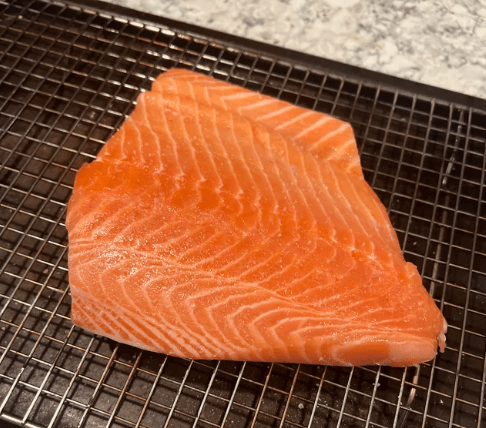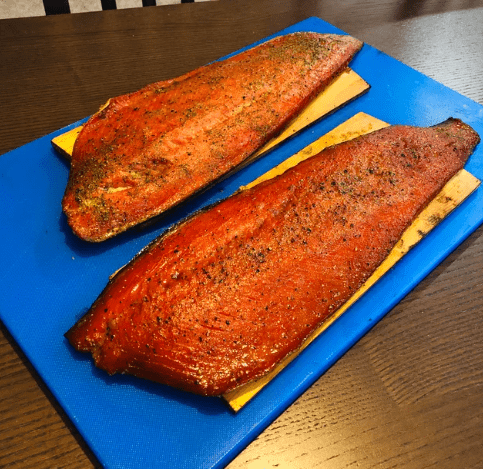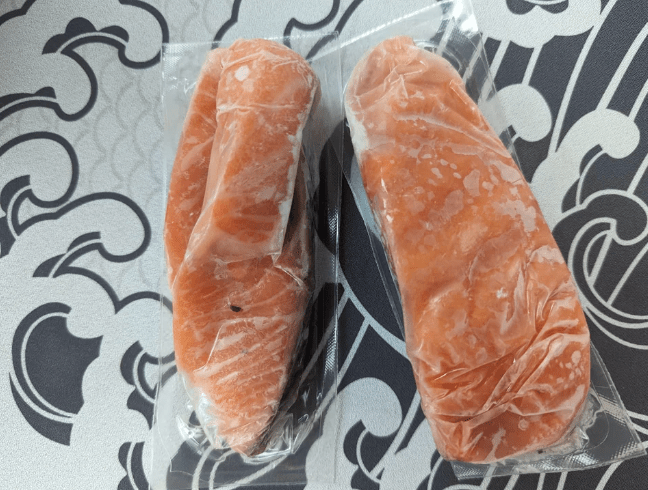Salmon is a very popular and versatile seafood choice around the world. It is known for its delicious flavor and numerous health benefits as it is high in protein, high on omega-3 fatty acids, and also has high vitamin D content. One common concern amongst people who cook at home and diners is how long cooked salmon can sit out at room temperature without risking spoilage or foodborne illness.
Let us explore the factors that affect the safety of cooked salmon when left unrefrigerated at room temperature, including right temperature to store, shelf life, and the importance of safe food storing and handling practices.
What Is A Salmon

Salmon is a family of fish that includes several species within them, some of the most popular ones being Atlantic salmon, Pacific salmon (such as Chinook, Coho, Sockeye, and Pink salmon), and amongst others. Even though they belong to the same family, the taste, texture, and color of the salmon will differ depending on the species and where it’s caught.
Salmon is widely consumed for its high nutritional value, as it’s an excellent source of protein, omega-3 fatty acids, vitamins (particularly B & D), and minerals. These nutrients that Salmon has provides various health benefits that have proven to improve heart health and brain functions.
Also Read: Plantains vs Bananas: Who Wins The Ultimate Nutritional Test?
Safe Handling Salmon

Before diving into how long cooked salmon can sit out, it is important to know if the salmon is stored and handled right when preserving it before use.
- Hygiene And Safety Guidelines
Precautious and safe handling is very crucial when it comes to salmon, just like any other perishable food items. It is very essential to maintain proper hygiene that involves wearing hair masks, face masks , deep clean tools before and after use, washing your hands before touching anything and wearing gloves. It is also important that you adhere to specific guidelines to prevent foodborne illnesses. Salmonella and other harmful bacteria can contaminate the salmon and can cause food poisoning. - Setting The Right Temperature
Making sure that the temperature that the salmon is stored in is around 32 degrees Fahrenheit (0°C) .40 degrees Fahrenheit (4°C) is the maximum storage temperature for fresh fish, it is also better maintained and has a longer shelf life if stored at 30.2 degrees Fahrenheit (-1°C) and 35.6 degrees Fahrenheit (2°C). The temperature range between 40 degrees Fahrenheit (4°C) and 140 degrees Fahrenheit (60°C) is called the “Danger Zone” in the key context of food safety, as this is the temperature range where harmful bacteria grow most rapidly.
Also Read: 6 Amazing Health Benefits of Pecan Nuts
How Long Can Cooked Salmon Sit Out?

Let us now learn more about how long cooked salmon can sit out:
- Immediate Consumption
The easiest and the safest way to consume cooked salmon is to enjoy it immediately when it’s hot, tender and juicy, just after preparation. Whether you’re eating at a diner, restaurant or at the comfort of your home, it’s best to serve and eat the salmon as soon as it’s ready. - Room Temperature Storage
It is totally understandable that it is not always possible to eat and enjoy the salmon immediately after preparation. If you have cooked salmon that needs to sit out for a short period time, for example at a buffet or during a picnic, it’s important to keep in mind and following safety guidelines:
- Two-Hour Rule – The Two-Hour Rule states that perishable foods like cooked salmon should not be left out at room temperature for more than two hours, and if the weather is hot like above 90 degrees Fahrenheit (32°C), the time should be reduced from two hours to one hour. Beyond these timeframes, the food is at risk of harmful bacterial growth rapidly or significant chance of being affected by foodborne illness.
- Chilled Serveware – To extend the safe period for serving cooked salmon at room temperature, opt on using chilled serving platters or trays. When the cooked salmon is placed on ice or ice packs beneath the serving dish, it can help maintain a lower temperature that will intern slow the bacterial growth.
- Refrigeration
The best way to ensure the safety and quality of cooked salmon is to store it in the coldest corner of the fridge. If the salmon is not consumed within two hours of cooking, transfer the leftover salmon into an airtight container or you can also wrap it tightly with plastic wraps. Now the properly stored cooked salmon can be kept in the refrigerator for almost three to four days without any problem. - Freezing
If you want to keep cooked salmon for a longer period of time, freezing it is the best option you got . Place the cooked salmon in an airtight container , you can also wrap it tightly with plastic wraps or a freezer bag, make sure to remove as much air as possible leaving no air bubbles inside the bag, and do not forget to label it with the date of freezing. Cooked salmon can be safely preserved in the freezer for up to two to three months without any problem.
Also Read: Turnips Vs Radishes
Human Indicators

No matter if you follow all the food safety guidelines and maintain proper hygiene when storing the salmon, there still are times when the salmon could turn bad and unfit for consumption. Here are some methods to check if your salmon is still edible:
- Visual Inspection
There are times when recommended guidelines or precautions can not exactly determine the status of your salmon, that is when it is essential to visually inspect the cooked salmon before consuming it. If you notice any signs of spoilage, it could be an off smell, discoloration on the surface, or a slimy texture on the body. It is well advised in your best interest to discard the salmon to avoid potential health issues. - Sensory Evaluation
Trust your senses when evaluating your salmon’s condition. Your sense of smell, touch and taste will definitely help you determine if your salmon has gone bad. If the salmon smells sour, rotten, “off,” or if it has an unpleasant taste, or has a slimy texture when you touch it, it’s a clear sign that it has spoiled. To put it in simple words, if the salmon makes you feel uncomfortable in any way, trash it right away.
Conclusion
The safety of cooked salmon when left out at room temperature depends on several factors, including temperature, time, hygiene and proper food storing and handling practices. Lets us look at a summary on how to minimize the risk of foodborne illness by following the guidelines below:
- Immediate consumption of cooked salmon is the best practice, do so whenever possible.
- If the cooked salmon is being left out at room temperature, it is important to adhere to the two-hour rule, or one hour in hot weather and also use the chilling method as a better precautionary measure.
- Refrigerate or freeze leftover cooked salmon to extend its shelf life and also maintain its safety and quality.
- Make it a point to always conduct a visual and sensory inspection before consuming cooked salmon.
Hey welcome to my blog . I am a modern women who love to share any tips on lifestyle, health, travel. Hope you join me in this journey!

Speak Your Mind